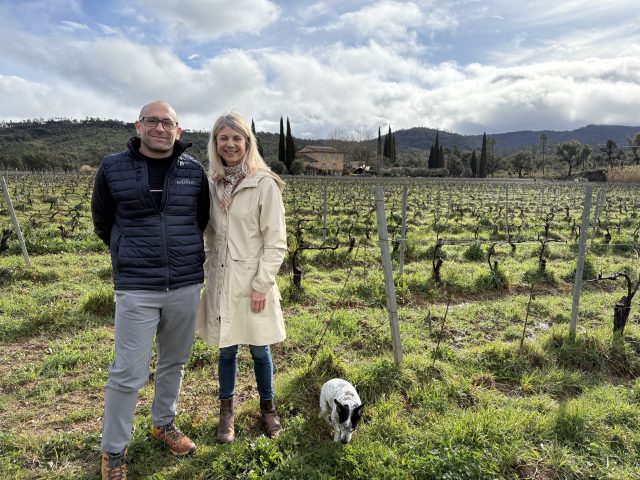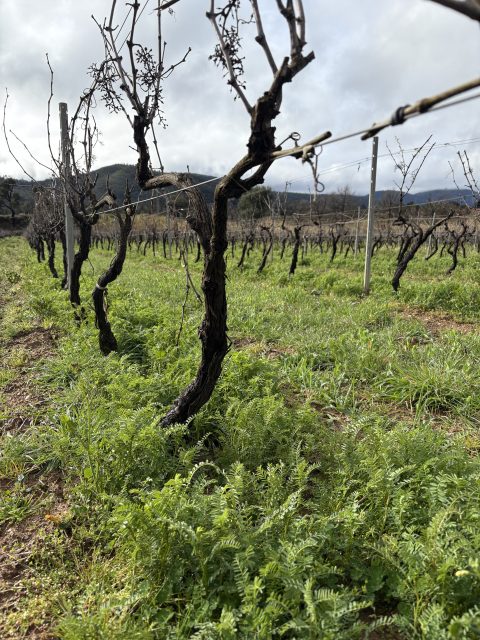How Provence is dealing with drought
In the increasingly extreme climate of Provence, producers are putting more faith in regenerative farming techniques to secure a healthy crop now and in the future, writes Patrick Schmitt MW.

“It was like a beach,” said co-founder of Mirabeau Wine, Jeany Cronk about the 20-hectare Provencal estate near Brignoles she bought with her husband in 2019.
So devoid of organic matter, the soils were a pale yellow, and they had become hard too, making them impermeable to water, she recalled, telling db earlier this year that the previous owner was “allergic to seeing a single weed”, and as a result, had liberally applied herbicides to the vineyards.
But Cronk had fallen in love with the estate, with its 13.5ha of vineyards surrounded by woodland, along with a stream dissecting the property, as well as a small farmhouse, which was used by the former occupiers as a holiday home.
“The grapes were being sold to the local cooperative, and the vineyards had been run with minimum effort and maximum yields,” she said, before noting that it was clear that there was the potential for quality from the vines, if they were managed with care.
The Mirabeau label was already established, built on the supply of grapes from a range of producers in Provence, but Cronk said it was always their plan to have a property in the region: “a place of our own, somewhere for experimentation, and a home for the brand.”
The first thing that the Cronks did was to apply for organic certification, which was granted in time for the 2023 harvest, but, she said, “We soon realised that organic was not enough, with a potential negative influence on soil life, because the main way to control weeds is by ploughing.”
As written about extensively already on this website, ploughing can diminish the amount of biomass in the soil and, as a result, the level of microbial life too – the action of tilling degrades the organic matter in the ground, while compacting the sub soil beneath.
It was then that Cronk heard about regenerative practices – a method to improve soils by leaving them permanently covered with plants. “It seemed logical,” she said, adding, “I couldn’t get my head around biodynamics.”
The widespread view in dry Provence is that anything competing with the vine for water is “terrible”, according to Cronk, but, the appeal of regenerative practices is that it “restructures the soil, and, if you manage the cover crop properly, then you have a mulch for the hot months, which lowers the soil temperature.” Meanwhile, a soil rich in organic matter acts more like a sponge when it does rain, absorbing and storing the water (see picture above for the puddle-free, regeneratively-managed Mirabeau vineyards following a period of heavy rain in March).
Before employing this approach, Cronk said, “Every time there was a big rainfall event, we had terrible run-off, and erosion too: all the top soil would be taken away.”
As for the impact on yields, Cronk admits that “there is definitely a transition period” – referring to diminished grape production as the vine adapts to sharing the soil with a range of plants. However, once a balance is achieved, the yields return to similar levels – which in any case, are constrained by the rules of the AOP for Provence.
Meanwhile, there are other benefits. “We can improve profitability because there are fewer tractor passes – and diesel is getting more expensive – and we think it will help to extend vine life,” she said.
Crucially, there is the ongoing issue of water use. With regenerative practices, Cronk says that the “soil temperature is lower and hydric stress is less,” which is vital for reducing the moisture requirements of the vine.
Although Cronk is only “hand watering” for establishing new vines, and “dry farming” for the rest of the estate (which receives around 600mm of precipitation annually), irrigation is increasingly widespread in Provence, both to ensure consistent yields, and deal with more regular periods of drought.
However, in the future, her belief is that regenerative measures will be increasingly necessary in Provence, due to the lower moisture requirements of a vineyard that is rich in biomass, and a diminishing supply of water. “Eventually we will all have to get used to dry farming: the water is limited here and the number of people in the Var is expanding all the time,” she said, pointing out that the needs of the local population and tourists will come before wine producers.
Expressing similar concerns is Vins de Provence managing director Brice Eymard, who told db in March this year that, “Water management is a very big issue.”
Partner Content
While the region benefits from the Canal de Provence, which carries water from the Alps to this coastal part of France, it doesn’t reach all wine producers, and prioritises the needs of people over farmers. “We have enough water for now,” he said. “But [for it to benefit everyone] we need to extend the pipes, which will take 10 years.”
He’s also not sure that the quantities provided by the canal will be enough for the future. As a result, Vins de Provence is “researching ways to make sure we only use water when it’s needed; so, it’s only the last solution”.
Part of this involves a project dubbed ‘living soils’ that seeks to improve the water-holding capacity of the vineyard. Trials are under way which tend to focus on raising the level of organic matter in the ground to make it better at absorbing water, as well as retaining it.
Another producer moving towards regenerative practices is the organic Bastide de Blacailloux, which is also focused on conserving water at its beautiful estate, featuring 30 hectares of vineyards dotted among forests, gardens and olive groves. Inspired by another beacon of sustainable Provençal wine production, Château Galoupet, Bastide de Blacailloux MD Rickman Haevermans told db that the estate is looking at ways to collect and store water.
“We have set a series of sustainability goals for 2030, and water is a big part of that,” he said. “We want to collect water from buildings and runoff so we capture everything from the rain, and we will store it in tanks as well in ponds,” he added, with the latter also enhancing biodiversity at the property.
For Eymard, another long-term solution to the hot, dry conditions in Provence may come with hybrid grapes, as well as Vitis vinifera varieties well adapted to extremes. Allowed for the past five years in the region under ‘experimental status’ are hybrids Floréal and Souvignier, as well as a couple of Greek grapes – Agiorgitiko and Xinomavro – according to Eymard. “So, we have four new varieties,” he said.
Elsewhere, at Domaine Bargemone, winemaker Pierre Einaudi has expanded the number of varieties at the estate to help deal with the challenges posed by a warmer and drier climate. “We have planted additional grapes such as Bourboulenc and Clairette for the whites and Counoise along with [hybrid variety] Caladoc for the rosés and reds, because they are better at surviving the heat and drought,” he told db, that is, compared to the main grapes used, which are Grenache and Syrah for the rosés and Rolle and Clairette for the whites.
Back to the subject of vineyard management, Eymard said that Vins de Provence has not yet banned the use of weedkillers, although it will consider doing so should, by 2030, producers “not be engaged in an environmental approach”.
At the moment, he said that 61% of the 28,000-hectare region practices cover cropping, with 40% of the surface area classified as HVE (Haute Valeur Environnementale), while 27% is organic.
In short, Eymard records that two-thirds of Provence is managing its soils sustainably, and the regional body is doing more to encourage the remaining growers to eschew the herbicides and increase the carbon content of their soils.
As a final point, Maison Mirabeau’s technical director Guillaume Cordonis said that regenerative farming in Provence does require ongoing experimentation. Among the approaches that have proved successful, he told db in March, is the use of vetch between the vines (see picture below), because it doesn’t grow high, and it suppresses other weeds that might grow upwards, towards the bunches.
He also said that he is using a technique called “hydro-seeding” to establish cover crops in the vineyard without turning the ground, while choosing some plants for “building biomass in the soil”, and others, such as clover, for “nitrogen provision”. Furthermore, he has an experimental plot that he hasn’t seeded, to see what a “natural cover crop” would look like, and whether it might be possible to run a vineyard that is “self-sufficient”.
Agroforestry is another technique on trial at Maison Mirabeau, with Cordonis planting almond and pistachio trees in place of dead vines. He said that the trees “will be maintained short so we can still use harvest machines”.
Also, to help keep the vineyard plants in check, Mirabeau are using a small herd of sheep “which you have to move through the vineyards quickly so they don’t compact the soil”, as well as two alpacas, because “they don’t overgraze”, said Cordonis.
Concluding, Cronk said that for “for new plantings, we will plant along the contours, so the vineyard collects and stores rainwater, and it doesn’t become a highway for water.”

Read more
Why it’s time to stop tilling your vineyard soils
Related news
Emiliana gains international regenerative agriculture accreditation




